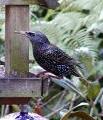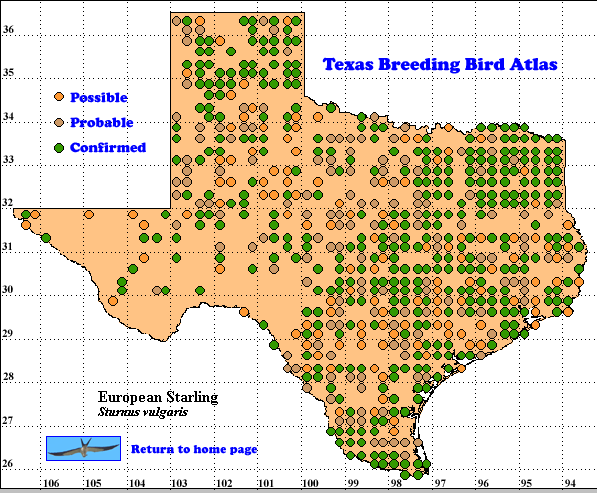The release of flocks totaling about 100 European Starlings in Central Park in New York City in 1890 and 1891 triggered an explosive expansion to an estimated population of 200 million birds spread across North America. The first starling was found in Texas in 1924, suggesting an almost exponential range and population expansion.
As a secondary cavity nester, this species competes aggressively for cavities with native species, even with woodpeckers that have just excavated a cavity. Starlings are omnivorous and opportunistic feeders. Diet varies seasonally and geographically, ranging from invertebrates in lawns, fruits, berries and seeds to garbage, animal feeds, agricultural produce and even abundant arboreal insects (Cabe 1993, Lockwood and Freeman 2004).
DISTRIBUTION. European Starling breeds widely across Texas except for the Trans-Pecos region where nesting sites are much more widely scattered. Winter distribution is similar as this species is resident in this state all year.
Outside Texas starlings breed from Alaska across northern Canada to Labrador and Newfoundland, and south throughout the lower 48 United States. In Mexico starlings are found in northern Baja California, south on the Pacific Coast of the mainland to Sinaloa and along the United States border. In the non-breeding season starlings are also found in the rest of northern and central Mexico, southern Baja California, the northern Yucatan Peninsula, eastern Cuba, the Isle of Pines, Puerto Rico and the Bahamas (Cabe 1993, Howell and Webb 1995).
SEASONAL OCCURRENCE. European Starlings are present all year in Texas. Individuals breeding in this state probably do not migrate, but migrants from further north augment winter populations (Lockwood and Freeman 2004). TBBAP participants saw starlings carrying material to cavities between March 18 and August 8, saw them in or near a cavity between February 27 and August 21, heard young starlings in cavities between May 6 and July 24, saw adults carrying food to cavities or recently fledged young from April 6 to July 7 and found recently fledged young from March 28 to July 5.
BREEDING HABITAT. European Starlings breed from sea level to about 1100 m (3600 ft), mostly in human-modified habitats (cities, towns, gardens, parks, orchards). The presence of woodpecker holes and suitable foraging areas (lawns) probably determines most nest sites. Starlings are generally less common in rural areas. The species uses woodpecker holes, bird houses or natural cavities (even among rocks), filling the bottom with a variety of vegetation and human detritus in which a cup is formed and lined with fine grasses and plant stems. The inside diameter of the lined cavity is 7.5 cm (3 in).
The female usually lays 4-5 pale bluish or greenish white, unmarked eggs and both sexes incubate them for 12 (range 11-13) days. Nestlings usually depart the nest on the 21st day after hatching. Two broods per year are frequent, intra-specific egg dumping is found in 15-33% of nests, and some males are polygamous, but cowbird parasitism is rare (Oberholser 1974, Harrison 1979, Cabe 1993, Lockwood and Freeman 2004).
STATUS. Lockwood and Freeman (2004) describe European Starling as common to abundant across most of the state, but rare to uncommon in the western half of Texas. North American Breeding Bird Survey (BBS) data indicate the highest abundances (10-30 starlings per BBS route) are found in areas described by Lockwood and Freeman as Coastal Prairies and the northern part of the Post Oak Savannah and Blackland Prairies, some of the most urbanized areas of the state. Densities decrease from these areas and are <1 starling per route in the Trans-Pecos and western Edwards Plateau (Sauer et al. 2004). Oberholser (1974) considered the species as common to uncommon in the northeastern two-thirds of Texas, southwest to Midland, San Antonio and Corpus Christi, and scarce and local south from there to the Rio Grande delta. The difference between these three descriptions suggests that European Starling has expanded its range in Texas in the last half-century. TBBAP atlasers found a number of confirmed or probable records for the Trans-Pecos region or on the western Edwards Plateau where breeding had not been reported before 1970.
BBS trend data for the period 1966-2003 show a statistically significant trend of 1.9% population increase per year, based on 145 routes, as compared to a system-wide trend of -0.9% change per year, based on 3460 routes across the United States and Canada (Sauer et al. 2004).
These trends indicate the population of European Starlings in Texas has doubled since 1966, while populations in areas colonized earlier have declined somewhat.
Text by Robert C. Tweit (2005)
Literature cited:
Cabe, P. R. 1993. European Starling (Sturnus vulgaris). In The birds of North America, No. 48 (A. Poole and F. Gill, eds.). The Birds of North America, Inc., Philadelphia, PA.
Harrison, H. H. 1979. A field guide to western birds’ nests. Houghton Mifflin, Boston, MA.
Howell, S. N. G. and S. Webb. 1995 A guide to the birds of Mexico and northern Central America. Oxford University Press, New York.
Lockwood, M. W. and B. Freeman. 2004. The TOS handbook of Texas birds. Texas A&M University Press, College Station.
Oberholser, H. C. 1974. The bird life of Texas, Vol. 2. University of Texas Press, Austin
Sauer, J. R., J. E. Hines, and J. Fallon. 2004. The North American Breeding Bird Survey, results and analysis 1966-2003. Version 2004.1. USGS Patuxent Wildlife Research Center, Laurel MD (Web site, http://www.mbr-pwrc.usgs.gov/bbs).

